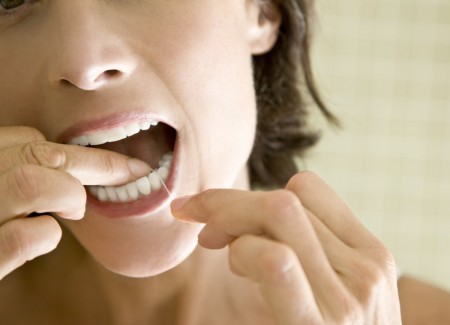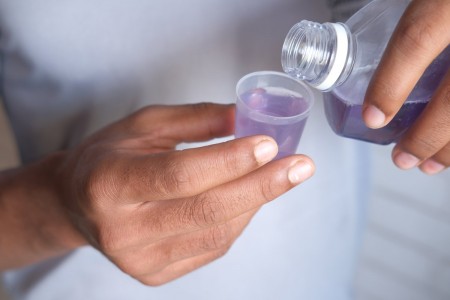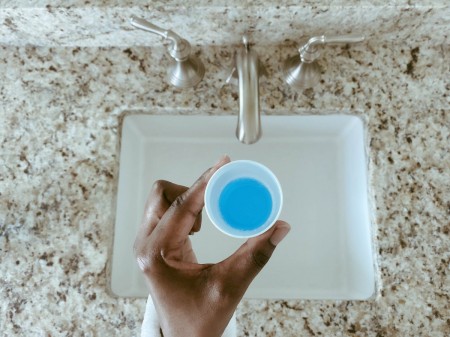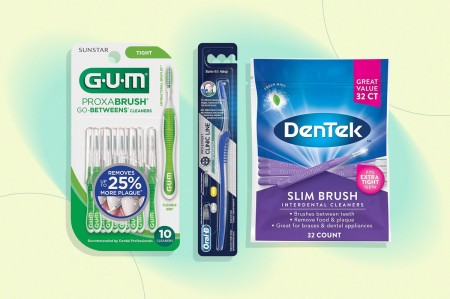
Advertisements
Flossing: The daily habit you should have, but if we're being honest, most of us don't. Just about one-third of adults 30 and older say they floss daily, according to the Journal of Periodontology. (Most people say they floss weekly, which is six fewer times than recommended, btw.)
Video of the Day
So, of course, the first order of business is to start flossing (more on that later), but there may be a best time to do it. Many dentists have advised LIVESTRONG.com readers to floss first before brushing in order to loosen up the food particles hiding in between your teeth so they can be effectively swept away by the brush.
In reality, though, you can still get an oral health benefit from flossing whether you do it before or after brushing, Lisa Maxwell, MSB, Dental Hygiene Program director and clinical assistant professor in the Department of Biomedical Sciences and Comprehensive Care at Indiana University School of Dentistry, tells LIVESTRONG.com.
That said, if you're starting to floss, you're better off doing it before you brush. "If you are trying to introduce a new habit of flossing, you might want to floss before you brush so you can't talk yourself out of it," she says, adding that this might take a couple weeks for the new habit to become automatic.
Why Floss?
Food particles and bacteria combine to create plaque that sits on teeth (you'll know it's there if you run your tongue over your teeth and things feel "fuzzy").
When plaque settles in between teeth, toothbrushes can't touch it, according to the American Dental Association. If you don't act (read: floss), plaque becomes tartar and it can only be scraped off at the dentist.
Plaque leads to both cavities, which can occur between teeth, and gingivitis, a condition that can lead to gum disease.
Related Reading
Advertisements
7 Foods That Are Bad for Your Teeth, According to a Dentist
How Often to Floss
Make flossing frequent. "Everyone should floss once a day, either in the morning or before bed," Maxwell says.
There are benefits to either choice. The good thing about doing it before bed is that you've got a whole day's worth of gunk built up that you need to get out of your teeth.
On the other hand, if you're too tired at night and resistant to adding another thing to your brushing routine, then tackling flossing in the morning is a great way to freshen up your mouth for the day.
How to Floss Your Teeth

Advertisements
There are so many different types of floss: string, waxed, soft/spongy, picks, interdental cleaners and water flossers. What you choose is based on what you like, says Maxwell. (And what makes you more willing to floss.)
"Waxed is good for tight contacts. Spongy floss is good for teeth with spaces between them or implants or crown and bridge work. Water flossers are good for cleaning around extensive dental work or braces," she says.
Next, follow this technique from Maxwell to floss like a pro:
- Pull out a piece of floss that's longer thanyour forearm. (Whoa, seriously.) "You want to use a clean section of floss [betweeneach tooth] you're flossing," she says. No need to, you know, push that biofilmback into your teeth.
- Wrap a small amount of floss around the middlefinger of one hand and then the middle finger of the other. You should see twoinches of floss between your fingers.
- Pinch your thumb and index finger together onboth ends of the floss and guide the floss between each tooth. Gently see-sawthe floss until the floss slides down to your gums.
- Push the floss gently against the tooth to makea "c" shape. Move the floss up and down. (The idea is to get around the tooth,not just quickly ping the floss down and back up.) Move the floss to the side ofthe adjoining tooth and repeat the "c" shape technique.
- Pull the floss up and unroll a clean section offloss, wrapping the used section around the other finger.
- Repeat until you've flossed each tooth.
Related Reading
This Is Why Your Morning Breath Smells So Bad






